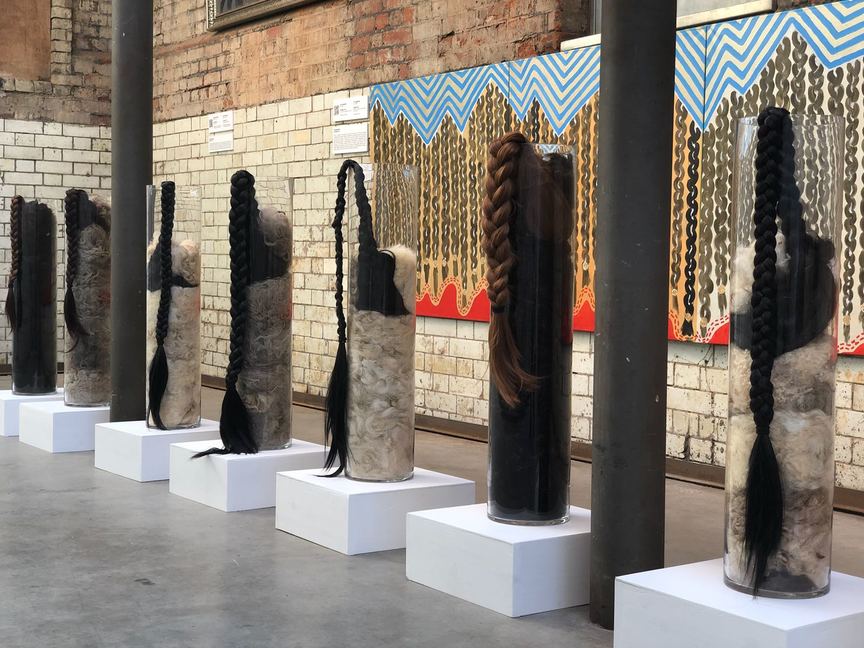-
From Current Issue
-
- Editor’s Letter Fire in the Heart
- Reviews I Gusti Ayu Kadek Murniasih
- Reviews 11th Seoul Mediacity Biennale: “One Escape at a Time”
- Dispatch Networked China
- One on One Monira Al Qadiri on Yukio Mishima
- Essays The rise of independent art spaces in pandemic-era Shanghai
- Features Tuan Andrew Nguyen
- Table of Contents
- Web Exclusives
- Archive
- Subscribe

R
E
V N
E
X
T
Installation view of “Focus Kazakhstan: Post-Nomadic Mind” at the Wapping Hydraulic Power Station, London, 2018. Photo by Thierry Bal. Courtesy the Focus Kazakhstan project.
Since its closure as a pumping station in 1977, London’s Wapping Hydraulic Power Station has been home to no shortage of exhibitions. Characterized by Victorian-industrial brickwork and remnant heavy machinery, it is nonetheless a particular and potentially jarring space to mount works of art. In “Focus Kazakhstan: Post-Nomadic Mind”—one of a series of related shows also taking place in Berlin, Jersey City and Suwon—however, the architectural details were among many other diverse and contrasting elements.
Installation view of SAID ATABEKOV‘s Battle for the Square, 2009, four-channel video installation, dimensions variable, and KAMILLA SANI-GABDULLINA’s Hoelun (Genghis Khan’s Mother), 2016/2018, mixed media instalation, dimensions variable, at “Focus Kazakhstan: Post-Nomadic Mind,” Wapping Hydraulic Power Station, London, 2018. Photo by Thierry Bal. Courtesy the artists and the Focus Kazakhstan project.
Representing a variety of aesthetics, the show, curated by Indira Dyussebayeva-Ziyabek and Aliya de Tiesenhausen, brought together contemporary Kazakh art by 32 artists, including works from the Soviet period and examples from what has most recently come to be called “post-nomadism,” all with a meticulous curatorial approach that has these items in conversation with each other. The most notable of the dialogues between the works was to be found in a central room of the Power Station, where four screens split across opposing walls displayed Said Atabekov’s Battle for the Square (2009), depicting an archaic game played by nomads, in which hundreds of players on horseback struggle in a violent melee. Suspended from the ceiling in the centre of the room was Kamilla Sani-Gabdullina’s Hoelun (Genghis Khan’s Mother) (2016/2018), a cloud-like object constructed from various fabrics and paper, referencing the name of the great Mongol leader’s mother, which means “cloud” in various Turkic languages. In combination, these two works formed an impressively nuanced example of “post-nomadism,” in which the artists look to a collective past with a capacity to both acknowledge and interrogate the brutality of certain traditions, while refusing to succumb to the readings of violence foisted upon one’s history from outside: Genghis Khan, still framed in the west as a ferocious character, is seen by many in Central Asia as a great leader, and is mediated in the video and installation with a sense of defiant serenity.
Outside the main building, beneath a corrugated metal shelter, were the eight glass tubes of Aza Shadenova’s installation The Homemaker (2018). Each of the cylinders is packed to half-way with raw sheep fleece and has a polyester plait—a symbol of womanhood—hanging from their rims, suggesting the compartmentalization and containment of various traditions and styles of living within the modern context, but also the containment of women and their labor within traditions.
Additionally, there were several fine examples of Soviet paintings by artists such as Kanafiya Telezhanov and Vladimir Eifert displayed. Yet the exhibition’s most impressive pieces were those that often drew from folk-arts that were popular before the regime’s imposition of western art practices on the region, remediating the rejection of traditional methods by contemporary artists immediately following the Soviet era. For example, tradition is engaged with to great effect in the case of Gulnur Mukazhanova’s installation False Hope or the Moment of the Present (2018): a floating, fragmented plateau of brightly coloured fabric where a multitude of planes hang at different heights, creating crisp shadows and, in the low-lit room, a feeling bordering transcendence.
Besides the richness and variety of works with discernable thematic roots, there were some that might easily fit into a more general contemporary art idiom, notable among them Gaisha Madanova’s Birdcatcher (2011), which was inspired by a scene at a market where living birds are packed into small sacks and hung from walls. In the installation, Madanova projects an image of a pouch hanging on a wall into the gallery, with the moving bag and its struggling contents aligned over an an actual sack mounted in the space. The effect is harrowing and visceral, an example of the kind of art that, without conceit or the need for wordy explanation, manages to be deeply evocative without sacrificing contemporary aesthetics or succumbing to sentimentality. Hidden away in a room of the Power Station that visitors might easily have missed, it complemented the other works in the show as a testament to the diversity of art from the region.
Ned Carter Miles is the London desk editor of ArtAsiaPacific.
“Focus Kazakhstan: Post-Nomadic Mind” is on view at Wapping Hydraulic Power Station, London, until October 16, 2018.
To read more of ArtAsiaPacific’s articles, visit our Digital Library.






